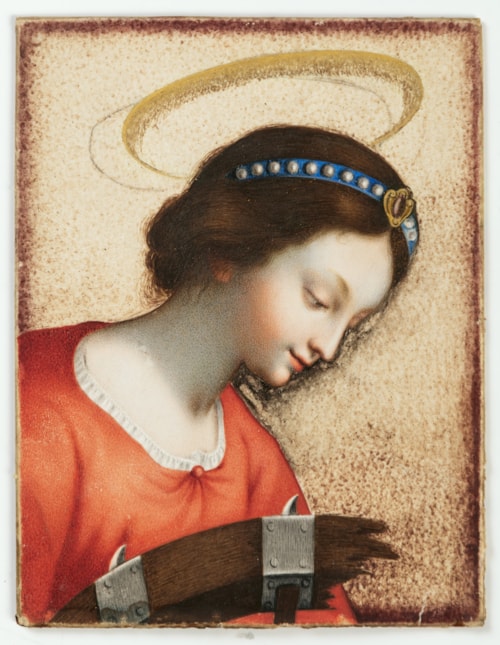
Giovanna GARZONI
Ascoli Piceno 1600 - Rome 1670
Biography
Giovanna Garzoni was probably trained by her father Giacomo in her native town of Ascoli Piceno in the Marche before moving to Venice in her early teens to study with the calligrapher Giacomo Rogni. Not only a gifted artist, Garzoni was, by a young age, also a fine musician and singer, as well as a calligrapher, having produced a manuscript of calligraphy samples decorated with miniatures of plants, flowers, birds and animals that she retained in her possession all her life. At the age of about fifteen or sixteen she was presented to Maria Maddalena of Austria, Grand Duchess of Tuscany, to whom she offered a miniature painting of Saint Mary Magdalene, now lost. It was on this initial visit to the Medici court in Florence that she probably first met and befriended the young painter Artemisia Gentileschi, who was a few years older. In 1622 Garzoni married the Venetian painter Tiberio Tinelli, but two years later the marriage was annulled, apparently unconsummated. She is documented in Venice in 1625, the date of a Portrait of a Young Man that is one of her earliest known miniatures. From the start of her career Garzoni was interested in the study of botany and developed a particular skill in the depiction of plants and flowers. In the early 1630s she produced a botanical manuscript entitled Piante varie, containing fifty watercolour studies of various plants, each drawn on a large scale with scientific accuracy. Among her earliest patrons and admirers in Rome were the scholar Cassiano dal Pozzo and Anna Colonna Barberini, wife of the nobleman Taddeo Barberini, Prince of Palestrina.
Garzoni was a gifted and versatile artist. As the scholar Sheila Barker has noted, ‘She worked in such varied media as large-scale oil painting, tempera-on-parchment miniatures, pen-and-ink drawings, pietre dure design, textile appliqué and painted fans, whereas her range of genres embraced devotional imagery, portraiture, still-lifes, miniature copies (which comprised some male and female nudes as well as landscapes), botanical illustrations, and even mythology.’ Garzoni led a peripatetic life, travelling and working throughout Italy; in Venice, Rome, Naples, Turin and Florence. (She may even have travelled with Artemisia Gentileschi to England in 1638.) Between 1630 and 1631 she worked in Naples, alongside Gentileschi, for the Spanish Duque de Alcalá, after which she spent five years in Turin at the court of Vittorio Amedeo I, Duke of Savoy, and his wife, Marie Christine of France. A period of over a year in Paris at the court of Christine’s brother King Louis XIII resulted in a number of fine works, notably a miniature portrait on vellum of Cardinal Richelieu.
Back in Florence in 1642, Garzoni spent nearly a decade at the Medici court, enjoying unfettered access to the treasures of the Medici collections of natural history and botanical specimens, and producing some of her finest works. She continued to receive commissions from Florence even after 1651, when she settled permanently in Rome, where she became an active and loyal participant in the activities of the Accademia di San Luca. Among the best-known of Garzoni’s later Medici commissions are a series of twenty remarkable still life compositions of fruit on a plate or bowl, each painted on parchment, executed between 1655 and 1662 for the Grand Duke Ferdinando II de’ Medici and subsequently displayed at the Medici villa at Poggio Imperiale. At her death in 1670 the artist left her estate to the Accademia di San Luca, on the condition that a monument in her honour be erected in the neighbouring Roman church of Santi Luca et Martina.
Garzoni’s highly original miniature paintings were generally executed in gouache or watercolour, often using a delicate stipple technique, on parchment or vellum, a prized and considerably more expensive medium than paper. The vast majority of her extant works are of still life compositions, especially of fruit and flowers, while she also produced a number of portraits and a handful of devotional religious subjects. With the exception of portraits, however, relatively few figural subjects are known. According to contemporary documents, Garzoni is known to have also made miniature copies on parchment after paintings by Andrea del Sarto, Raphael, Guido Reni, Annibale Carracci and Sassoferrato, among other artists. A large number of works by Garzoni were to be found in Florentine collections in the 17th and 18th centuries, and many examples remain in the Uffizi and Palazzo Pitti today.


